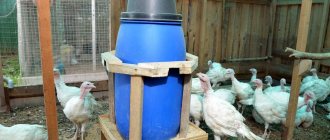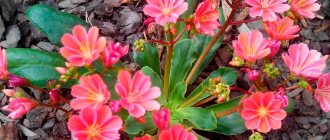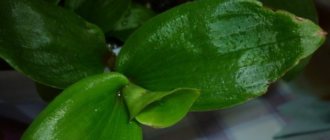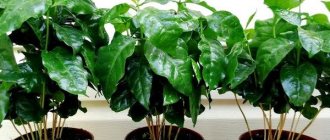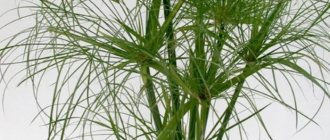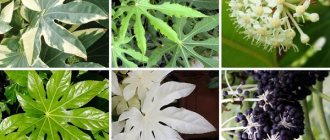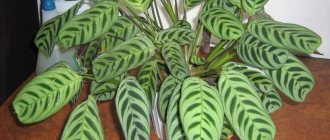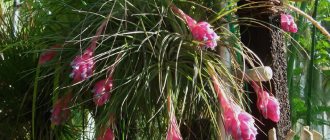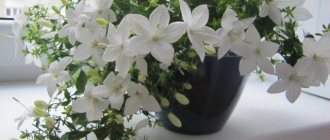Among the indoor plants, one flower is notable, it looks like a small baobab, covered with flowers reminiscent of roses. This is adenium, which got its name from its habitat - Aden, where Europeans first discovered a beautiful flowering tree. Caring for adenium at home will be discussed in this article.
Origin and appearance
In nature, adenium is found in sultry Africa, from Senegal, Sudan to the Arabian desert. It has many names: Desert Rose, Impala Lily, Star of Sabinia. Adenium has many faces in its species diversity. Depending on the place of growth and conditions, the following plants are found:
- with a thickened bottom ( caudex ), reaching a height of two to five meters;
- in the form of a small bush.
Adenium in nature
Regardless of the height and shape of the trunk, the branches have a rosette of leaves at the end, decorated with large flowers. Under natural conditions, flowers have shades from white-pink to bright red and purple. The plant belongs to the woody or shrubby succulents of the Kutrovaceae family.
The plant, accustomed to the high temperatures of Africa, feels comfortable on the windowsills of our apartments. Under natural conditions, adenium feels comfortable at a temperature of 30-35 degrees. Therefore, the hot summer of central Europe makes it possible to provide comfort for this flowering succulent.
The flower feels good on a south or east window.
On particularly hot days, it is recommended to shade the caudex (or the entire plant) with light tulle.
Necessary conditions for cultivation
If you know how adenium grows in nature, growing it at home will not be difficult. The plant, also called “desert rose”, is very unpretentious. In order for it to grow well and delight you with abundant, long-lasting flowering, you need to choose a suitable place, take care of lighting, humidity and air temperature. If you take into account all these important points, adenium will certainly take root at home.
Location and lighting
The adenium plant is quite light-loving. Therefore, it is recommended to place it on windows on the south side. This location is also suitable for succulent according to Feng Shui. It should be taken into account that in the hot summer period, under the influence of sunlight, the trunk can get burned. Therefore, the indoor plant needs to be shaded.
Temperature and humidity
Ademiums are resistant to high temperatures. The optimal temperature for them is 30-35 degrees. When these indicators are lowered by five units, no discomfort arises. In this case, prolonged cooling to 20 degrees will lead to a stop in growth, failure to flower and the onset of a dormant period.
A depressed state is observed in an excessively hot room. A temperature of 38 degrees with insufficient humidity is critical. Plants need to be grown in optimal conditions. At high temperatures, humidity should increase, and at low temperatures, it should decrease significantly.
It is unacceptable for the air to cool below ten degrees. In this case, the root system is affected and the plant dies.
Succulents are characterized by dormant periods. In this case, the plant exhibits the following changes:
- sheds leaves;
- stops growth;
- stops the process of formation of new buds.
Popular varieties
Botanists still cannot come to a consensus on how many species of Adenium exist in nature. Depending on the shape of the caudex, leaves, and habitat, ten main species are distinguished. Although other scientists are of the opinion that all species diversity comes from the main species - Adenium Obessum.
The development of desert rose breeding occurs mainly in the countries of Southeast Asia: Thailand, the Philippines and others. This is due to the fact that the climate is suitable for growing Adeniums. Many new varieties of indoor desert rose have been developed in these countries.
Obesum
Adenium Obesum
Among flower growers, the most widespread variety is Adenium Obesum. Its second name is Adenium Obese or thick. Under natural conditions, the above-ground part of the caudex grows to a meter thickness, and the plant reaches a height of up to three meters. Green leaves are oblong, rounded in shape, with pointed ends. There are varieties in nature with variegated leaves, glossy or dull.
The flowers of Adenium Obesumi are large, 5-7 centimeters in diameter. Selected varieties are distinguished by a variety of colors: from snow-white to dark red, burgundy flowers.
The plant begins to bloom at the age of one and a half to two years, but much depends on the growing conditions. Flowering duration is at least two to three months. At suitable temperature conditions, Adenium pleases with long-term flowering.
Arabicum (Arabicum or Arabian)
Adenium Arabicum (Arabic)
This variety differs from other Adeniums in its large leaves and dark brown bark. The flowers of Adenium Arabicum are red-pink. The plant got its name from its place of growth in nature - the Arabian Peninsula. The caudex has a massive, squat appearance. Depending on the habitat, the type of trunk can vary: from a thick tree to a shrub in places with a minimum of moisture.
Multiflora (Multiflora)
Adenium Multiflorum (Multiflorum)
The name Multifloral Adenium speaks for itself. This species is characterized by abundant flowering and grows in the central and southern regions of the African continent on saline or sandy soil. A thick trunk, expanding downward, goes deep with powerful roots. It is not afraid of droughts, because the powerful trunk serves as a storage facility for water reserves. The plant can reach three meters in height under natural conditions.
This may be interesting: Euphorbia (Euphorbia) - care tips
This variety of Adenium is also called Impala lily. In indoor floriculture, the plant is less common than Adenium thick, which is due to its slow growth, and as a result, flowering occurs after four years.
Mini
Adenium Mini
About ten years ago, breeders from Taiwan received mini Adeniums. These dwarf trees look like bonsai and decorate the interior in themselves. They are characterized by slow growth, and in 4-5 years they reach twenty centimeters. Intense flowering begins at two to three years of age and continues throughout the year, unlike other varieties. The size of the flowers is quite large for dwarf plants, reaching seven centimeters in diameter. Varieties of Adenium mini differ in the color of their buds - from white to bright red.
Dorset Horn
Adenium Dorset Horn
" appeared . Dorset Horn sheep In addition to the curled leaves, Dorset Horn has shorter branch internodes.
A special feature of this variety is the instability of its characteristics during propagation. If you graft Dorset Horn onto another Adenium, the leaves become even, the branches lengthen due to the increase in internodes. Therefore, this variety is propagated only by cuttings or aerial rooting. Although even with this method, the characteristics of the variety are not always fully preserved.
Anouk
Adenium Anouk
The Anuk variety is distinguished by thick, fleshy leaves of a slightly elongated shape. The plant grows up to half a meter. The variety is distinguished by early flowering with a large number of bright pink flowers.
Desert rose flower or adenium - what it is and what it looks like
Adenium is a deciduous plant that belongs to the Kutrovaceae family. Initially, this rose was found only in Egypt, Thailand, Malaysia and North Africa. However, now flower growers from almost all countries are engaged in growing the flower.
Desert rose - a beautiful and unusual flower
The main feature of the desert rose can be considered its height. The tree can grow up to three meters. However, when grown at home, the desert rose is not so tall and reaches only 60-70 centimeters. Also among the features of the plant one can highlight its trunk, which is thicker at the bottom and because of this stands out noticeably.
The side stems of adenium are covered with perfectly smooth gray bark. Sometimes its shade changes, causing the surface of the stems to become lighter, with a greenish tint. The plant has a well-developed root system. The root grows widely underground if the flower is properly cared for.
The side shoots of the plant are covered with flowers and leaves. The foliage grows on small petioles. It has an oval shape and is painted in a bright greenish color. The sides of the leaves are smooth, and the edges are more pointed. The average length of each leaf is 10-15 centimeters.
A planted plant can bloom only at the age of two. First, a small number of rare and single flowers are formed on the crown. However, gradually there are more of them and the tree is completely covered with flower buds. The petals are painted bright pink. At the same time, the middle of the flower is brighter.
Additional Information! The plant blooms for 3-4 months. However, with proper care, it can please the owner twice as long.
Features of planting desert roses
When planting and replanting Adenium at home, you should carefully choose a pot. The roots of the plant develop quickly and wide, so the pot should be wide and not deep. To avoid stagnation of water, the pot must have a sufficient number of drainage holes.
You should pay attention to the color of the pot. It doesn’t matter what material the pot is made of, it is important that it is light. Otherwise, in the hot sun, the roots will overheat, which will lead to their death.
The roots grow quickly, so Adenium is replanted as needed. It is recommended to carry out the procedure during the period when active growth begins, in the spring. A layer of drainage (2-3 cm) is poured onto the bottom of the pot, the roots are straightened, carefully sprinkled with soil. After transplantation, the plant should not be watered for two to three days.
When choosing soil for Adenium, you should pay attention to lightness, looseness, and breathability. According to the acidity value, the soil should be neutral or slightly acidic. You can purchase ready-made soil for succulents and orchids. To make it loose, crushed charcoal, perlite, vermiculite, and coconut fiber are added.
The mixture for Adeniums is easy to prepare yourself. To do this you need to take the following components:
- deciduous humus soil (30%);
- perlite, fine expanded clay, river sand (20%);
- coconut fiber (50%).
Add a small amount of crushed charcoal. Before use, it is advisable to disinfect the soil in the microwave or treat it with a fungicide.
Attention! Adenium is a poisonous plant. Care must be taken when transplanting and cutting. It is better to work with gloves and wash your hands thoroughly after care procedures. If small children and pets live in the house, then it is better to refuse to keep the plant in the apartment.
Preparation and planting
To ensure that the adaptation of the flower is painless and it immediately begins to grow, you should follow certain recommendations for planting it. There is a certain landing technology. In addition, soil preparation is of no small importance.
How to prepare the pot and soil
Planting of adeniums should be carried out in a loose, light, permeable to oxygen and moisture, as well as nutritious soil mixture. Acidity should be maintained within 5.5-7 pH. To get such soil, you need to mix:
- ready-made substrate (5 parts);
- leaf soil containing a sufficient amount of humus (3 parts);
- vermiculite or river sand (2 parts).
- It would also be useful to add charcoal to the composition.
The pot should not be very large. Otherwise, you will have to wait quite a long time for flowering. A cramped container is also not suitable for planting. Otherwise, the shape of the trunk will not be harmonious.
Caring for Adenium at home
Adenium's spartan life in natural conditions allows it to perfectly adapt to apartment conditions. It has already been mentioned that it feels comfortable at high summer temperatures, reaching 35 degrees. But it is necessary to pay attention that if the heat exceeds 38 degrees, an additional increase in air humidity is necessary.
This may be interesting: Money tree - care at home
Lighting
Adeniums need bright sun to develop and bloom. But the following nuances should be observed:
- In young plants, the base of the stem should be protected from burns.
- During the growth period, do not turn the plant, because parts that were in the shade may get burned.
- When moving a flower from a dark place to a brightly lit one, it should be gradually accustomed to the sun.
In winter, it is necessary to increase daylight hours to 12 hours using artificial lighting.
Watering
The amount and frequency of watering Adenium, illumination and air temperature are inversely related. At high temperatures, during the growth period, increase the frequency of watering. Watering is done when the top layer of soil has dried. When the temperature drops to 18-20 degrees, watering is reduced so that the soil dries out completely. Otherwise, rotting of the roots cannot be avoided.
If the plant is wintered at a temperature of 10-15 degrees, then watering is stopped completely. When leaving dormancy, watering begins in small portions after the buds swell, and only on warm sunny days.
Soft, settled water at room temperature is suitable for irrigation. From time to time you can slightly acidify it.
Top dressing
For active growth and flowering, Adenium needs fertilizing, especially if the soil contains a lot of coconut fiber and is not rich in nutrients. At the beginning of active growth, a predominance of nitrogen fertilizers is desirable, enhancing the growth of green mass. During flowering, phosphorus-potassium fertilizers are added to ensure lush and long-lasting flowering. The frequency of feeding is 1-2 times a month.
Dormancy and flowering period
In winter, it is recommended to place Adenium in a cool room, an insulated balcony at a temperature of ten to fifteen degrees, but not lower than ten. Only adult individuals can survive a drop in temperature, and only with dry soil.
During wintering, Adenium may lose all its leaves, but do not worry - this is a normal transition to a dormant state. If it is not possible to ensure the ideal wintering temperature, then you should move the plant to the coolest place in the apartment, watering in small portions after the soil has completely dried.
With the beginning of the active phase, the buds awaken and new leaves grow. The beginning of flowering of a young plant begins at the age of 1.5-2 years. But some varieties bloom after four years.
What to do if Adenium does not bloom? If a plant that has already delighted you with its beauty does not bloom, then you need to look for errors in care. These could be the following mistakes:
- abundant watering during the dormant period;
- root rotting;
- lack of sunlight;
- excess nitrogen fertilizers and lack of potassium fertilizers.
A little about adenium transplantation
First, you need to understand why or why you decided to transplant your handsome dog? There may be several reasons:
- the plant is quite large, and the trunk occupies more than 3/4 of the surface of the soil in the pot;
- 2 or more years have passed since the previous transplant of an adult plant;
- there is a suspicion of root rot;
- you have decided to form a caudex.
The next aspect is the tub itself into which you will transplant the adenium. The material is not particularly important; you can use both plastic and ceramics, the only thing is that when choosing clay pots, be careful, as there have been cases when the powerful root system of a flower simply tore them apart. The shape of the container directly affects the shape of the above-ground part; the squat and wider the pot, the wider the crown of the plant will spread, and the wider the trunk will be. In the new “home” for our indoor plant, it is simply necessary to organize good drainage, for this there must be a lot of holes in the bottom, then they are closed with expanded clay or pieces of clay (brick fragments will do, but without sharp edges) and sprinkled with coarse river sand and can be planted. The best size for two-year-old and older plants will be a pot diameter equal to two diameters of the trunk of the transplanted plant. And one more thing: in the wild, a “desert rose” can grow to very large sizes, and at home too, but only if you provide it with enough space to grow, for example, by constantly enlarging the pot. So, if you don’t want to end up with a giant in your apartment (or house), don’t replant the adenium too often and rationally select the size of the tubs. Let's move on directly to replanting. Remove the plant from the pot by turning it upside down. Clear a little of the soil from the roots of the plant and carefully inspect it. If there are signs of root rot, remove the affected areas to healthy fibers. Next, treat the cuts with charcoal and dry them for 2-4 hours, and you can start planting. If the roots were not damaged during replanting and you did not cut off the rotten ones, then you can immediately begin watering the plant according to the usual schedule. If there are bare areas in the root system, you can start watering only after a week. The best time to repot is just before the active growth phase - early or mid-spring. I would also like to draw your attention to the plant’s incentive to flower: when the root system completely fills the pot, the plant begins to think about other methods of reproduction that differ from simple growth “in all directions”, and most likely, in the near future, it will bloom.
Related posts:
- Aichrizon - the pubescent leaves of this succulent will bring you love. Do you want to grow a money tree, but don’t know if you can do it? And here is a “tester” for you to test your capabilities. Contents1 Description2 Types3…
- Pineapple is neither a fruit nor a vegetable! We will teach anyone how to grow it themselves. Pineapple has a beneficial effect on the condition of the whole body, improves mood no worse than chocolate, and also muffles the feeling of hunger. We…
- Beloperone with bright feather flowers seems to have come from a fictional world. Red, yellow, iridescent flowers of Beloperone growing indoors will attract so much attention that you will start it even a little...
- European olive is a fruit-bearing tree in your home. With a little effort, you can get olives yourself. This will be an environmentally friendly product grown, as a bonus, with love. Contents1 Description of the plant2 Classification3...
- A plant with 3 names: Nolina, Bocarnea and the “bottle tree”. This strange foreign tree can already be bought in our stores. And with the help of the information from the article, you will definitely be able to grow...
Crown formation
One of the reasons why the plant is so loved by flower lovers is that by trimming Adenium, shaping the crown and caudex, you can get miniature trees - bonsai.
To form a lush crown, seedlings are pinched before growth begins. In adult plants, the branches are shortened, leaving 5-8 cm. There is another way to form Adenium - cutting off the main trunk above the caudex. Soon, lateral buds begin to form along the circumcision perimeter. If you trim too low, many new branches will be thin, which can ruin the appearance of the flower.
Video: Trimming Adenium at home.
There is a way to increase the caudex by raising the roots during transplantation. Sometimes a small piece of plastic is placed under the roots so that the growing roots resemble a mango tree.
How does the caudex form in adenium?
This question plagues many amateur gardeners. I’ll tell you honestly, the process of forming a beautiful caudex is very difficult, but still, if you have the desire, patience and time, it is feasible. Have you ever seen a plant on a rock, bonsai style? So with adeniums it is possible to do something similar. We recommend that you use young cuttings that have just sprouted their roots to form a beautiful pattern from the roots of the plant. Due to the fact that the roots of the cuttings are formed along the perimeter of the trunk, you can easily get an “octopus” from them. To do this, we place the young plant on some object, expanded clay or something similar may be suitable (some manufacturers offer special disks that prevent the roots from growing downwards and force them to crawl horizontally) and plant them in suitable soil. Caring for the “octopus” is practically no different from caring for ordinary adenium, except that the frequency of watering needs to be increased. As it grows, the object is removed from under the roots, and all that remains is to transplant the plant higher so that the aerial roots are better visible. With a good imagination, you can get stunning results that even owners of bonsai trees will envy.
Diseases and pests of Adeniums
Despite the toxicity of the flower, it can be affected by pests and diseases. The main pests and methods of controlling them are given in the table.
| Signs | Pests | Treatment |
| Whitish coating on the roots. The flower slows down its development, the leaves turn pale, the trunk and branches lose their elasticity. | Root mealybug | Till the soil with Actor and Regent three times every 10 days. |
| A white coating appears on the leaves of the plant and in the leaf axils. | Mealybug | Treatment of leaves with Aktar, Fitoverm by spraying at intervals of a week. |
| Adenium leaves turn pale and become covered with yellowish dots. When spider mites spread, cobwebs are visible on the leaves. | Spider mite | Treat with acicides (Talstar, Actofit) several times with an interval of 3-10 days. |
| Slow decline of the plant, accompanied by distortion of the shape of leaves and flowers, the appearance of spots on leaves and flowers that are not characteristic of this variety. | Viral diseases | Sick plants must be destroyed to prevent the spread of the disease. |
| The appearance of insects on the leaves, their wilting | Aphid | Treatment with insecticides according to instructions |
| Softening of the trunk, appearance of black spots. | Caudex rot | Caused by excess moisture in the soil. Trim the root above the rotting area and root. At the onset of the disease, you should stop watering for 2 weeks, then replant the plant. |
| Brown spots on leaves | Bacterial burn | Soil treatment with a weak solution of potassium permanganate and Baikal-Em fertilizer. |
This may be interesting: Pedilanthus - features of care at home
Errors in care
Adenium, despite its unpretentiousness and adaptability, often suffers if it is not properly cared for. Let's consider the reasons and their manifestation.
| Manifestation | Causes | Elimination |
| The tips of the leaves turn black. | Too much watering, poor soil permeability | Watering is reduced, and the soil mixture is changed if necessary. |
| The leaves turn black, fall off, and the trunk turns black. | Abundant watering at low temperatures. | Move to a warmer place, reducing watering. |
| Brown spots on leaves. | Sunburn. | The order of adaptation to the sun is disrupted and disappear the next year after the leaves are renewed. |
| Rapid withering of buds. | Lack of moisture at high temperatures. | Spraying without getting on the buds or finding a less hot place. |
| The tips of the leaves dry out. | Sudden change of environment, infrequent watering, intense light. | Errors in care and maintenance are eliminated. |
Characteristics of crop species and varieties
To date, botanists have not come to a consensus and cannot accurately answer how many species of adenium actually exist.
One thing is clear that the most famous representatives among them are:
- Arabicum. Its homeland is the Arabian Peninsula. The peculiarity of this plant is that it has an unusual brown color of the trunk, as well as large leaves. If a tree lacks moisture, its caudex will become thin, like that of an ordinary shrub.
- Obesum reaches a width of 1 m, and can grow up to 3 m in height. The plant has large attractive flowers with a diameter of about 7 cm.
- Multi-flowered. This species, as the name implies, is famous for its abundant flowering. Its peculiarity is that the plant is able to accumulate a lot of moisture in its stem. Under natural conditions it can grow up to 3 m.
- Mini. This dwarf species is very similar to bonsai. The flower grows slowly and in 5 years can barely reach 20 cm. Nothing can affect its growth rate. Flowering begins at 2-3 years and lasts throughout the whole year. This property is characteristic only of the Mini variety; other types of adenium are not capable of this.
Reproduction of Adenium
Desert roses are propagated in different ways:
- cuttings;
- air layering;
- seeds.
To propagate Adenium by cuttings, use twigs obtained during spring pruning. Cuttings 10-15 cm long are suitable, the cut of which is sprinkled with crushed charcoal (activated) charcoal and dried, like all succulents. For planting, use a mixture of perlite, sand and charcoal. Place in a warm, well-lit place. Monitor humidity, avoiding excess. The cuttings take root within a month. Rooting cuttings in water requires changing the water daily to avoid rotting.
1
2
3
Aerial shoots are used for propagation in early summer, during the active growing season. On a branch no more than two centimeters thick, an incision is made in a circle, which is sprinkled with a root growth stimulator, wrapped with sfarnum moss, and secured with opaque tape. The moss is kept slightly moist. After the roots have formed, the plant is replanted separately. But this method of propagation leads to the fact that the new plant will not have a caudex.
Rooting aerial shoots
Seeds for growing Adenium at home can be bought in special stores. They are soaked for half an hour in a weak solution of potassium permanganate, then placed in a zircon solution and kept for several hours. The seeds are placed on a mixture of sand, vermiculite and charcoal, and sprinkled with a thin layer. It is recommended to place the pots in a warm place (30-35 degrees), then after a week you can expect sprouts to appear. Seedlings need additional lighting, compliance with humidity and temperature conditions, and daily ventilation. When the first leaves appear, increase the ventilation time, preparing for new conditions. After the appearance of the second leaves, the seedlings are transplanted into separate pots with a dive.
Growing Adenium from seeds
Types of adenium
Adenium is a wonderful garden decoration in the summer
The species diversity of adeniums is quite large. Consider the types of desert rose .
Adenium obesum
Adenium obesum
Adenium obesum Obesum is also called Adenium obese or thick. The species includes low trees or shrubs of the Kutrovye family. It is noteworthy that the lower part of the trunk has an interesting thickening. The species gained popularity due to its flowering. When grown indoors, it grows no more than 0.5 m in height. It is easy to care for.
Adenium somalense
Adenium somalense
Somali adenium (Adenium somalense) Under natural growing conditions it reaches 5 m in height, the trunk at the base cannot be hugged, since its diameter is 1 m. The leaves are narrow with a glossy shine, 15 cm long.
Varietal representatives are small in size and are successfully grown by gardeners.
Arabic adenium (Adenium arabicum)
Adenium arabicum
Arabic adenium (Adenium arabicum) In nature, it can be found along the southern and western edge of the Arabian Peninsula. Since the exotic Arabian adenium comes from arid regions, the trunk has a wide above-ground caudex, 1 m in diameter. A good species for growing bonsai.
Adenium socotranum
Adenium socotranum
Adenium socotranum The tallest species of all presented. The trunk reaches 4.5 m, the diameter at the base approaches 2.5 m.
Adenium socotranum is a miniature baobab. Some trees have elaborate flat trunks that create a fantastic atmosphere with their appearance.
When grown at home, the tree does not shed its variegated leaves for the winter. Winter maintenance is desirable for succulents. When the room temperature drops, reduce watering.
Adenium socotranum flower
Adenium boehmiaum
Adenium boehmiaum
Adenium boehmiaum The largest-flowered species. Huge flowers, pink in color, reach 7 cm in diameter. The leaves are large, pubescent on both sides. They are warm and velvety to the touch.
Adenium swazicum
Adenium swazicum
Adenium swazicum Swaziland adenium is characterized by slow growth. You cannot find specimens with a trunk higher than 30 cm. The platinum leaves are medium-sized and pubescent. The diameter of the flowers is 5 cm. Flowering occurs in mid-summer. It causes difficulties for flower growers; if he does not like the conditions, the tree stops growing and enters into some kind of stagnation.
Adenium multiflorum
Adenium multiflorum
Adenium multiflorum is famous for its lush flowering. The color of the flowers is attractive and quite bright. A wide red border runs along the edge of the petals. Growing is not difficult.
The website presents various varieties of adeniums that can be purchased at a competitive price.
